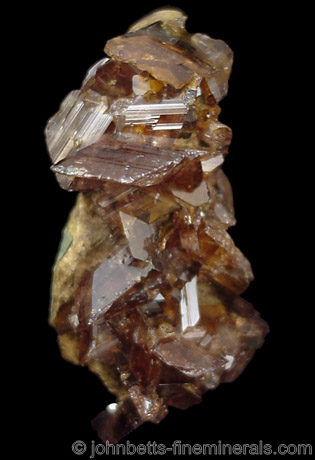The axinite Mineral Group

Axinite is the group name for several closely related minerals: Axinite-(Fe), Axinite-(Mg), Axinite-(Mn), and Tinzenite. Axinite on its own without a sub-designation is
not recognized as an individual mineral species by the IMA, although many mineral
collectors still refer to it by its
traditional name without further classifying the type of Axinite. Most of the known Axinite minerals are of the Axinite-(Fe) type.
Axinite was named in 1787 after the Greek word axine, which means "ax", in allusion to the sharp crystals of this mineral. The individual member types were originally Ferro-axinite, Magnesio-axinite, and Mangan-axinite. These were renamed with a suffix designation for easier cataloging reference by the IMA in 2008.
Chemical Formula
The inclusive formula for Axinite, encompassing all members, is:
(Ca,Fe,Mg,Mn)3Al2BSi4O15(OH)
Individual members are:
Axinite-(Fe): Ca2FeAl2BSi4O15(OH)
Axinite-(Mg): Ca2MgAl2BSi4O15(OH)
Axinite-(Mn): Ca2MnAl2BSi4O15(OH)
Tinzenite: (Ca,Mn)2MnAl2BSi4O15(OH)
Color
Smoky brown, dark brown, purplish-brown, greenish-brown, gray, black. Less commonly purple, blue, green, orange, or yellow. Very rarely multicolored. Axinite is strongly dichroic.
Properties
Streak
Colorless |
Hardness
6.5 - 7 |
Transparency
Transparent to nearly opaque |
Specific Gravity
3.3 - 3.4 |
Luster
Vitreous |
Cleavage
2,1 |
Fracture
Conchoidal to uneven |
Tenacity
Brittle |
Other ID Marks
Axinite-(Mn) from Franklin, New Jersey has a red fluorescence. |
Crystal Habits
Axinite forms in characteristic, flattened tabular crystals with sharp edges, and in dense groups of such crystals. Also grainy, bladed, columnar, in platy aggregates, in rosettes of sharp crystals, and massive. Crystals are often striated or have parallel line growths.
Uses
Axinite is primarily a collectors mineral, and the sharp, transparent forms are highly collectible and valued.
Noteworthy Localities
Some of the finest Axinite crytals have come Le Bourg de Oisans, France, as large, well-formed, transparent crystals. Sharp, platy aggregates, often coated with Chlorite have come from the Medel Valley, Grischun, Switzerland. A classic locality for Axinite is the St. Just District, Cornwall, England, especially at Stamps and Jowl Zawn at Botallack. Russia has produced exceptionally well-formed, large transparent crystals, often doubly terminated from Puiva, in Saranpaul. Also in Russia is the famed locality of Dal'negorsk, Primorskiy Kray, which has produced distinct, pointy aggregates of Axinite.
In Japan, dark Axinite crystals came from the Obira mine, Ono-gun, Oita prefecture; and the Toroku mine, Takachiho, Miyazaki Prefecture. The Shigar and Tormiq Valleys, Skardu District, Baltistan, Pakistan, have produced gemmy, alpine-type formations of this mineral. Nice brown crystals for Axinite have been found in Tasmania, Australia, at Colebrook Hill.
In the U.S., the premier Axinite locality is the New Melones Dam Spillway, near Copperopolis, Calaveras Co., California, where sharp brown crystals were found in a one-time construction find. In Canada, gemmy crystals come from the Grey Cloud Claim, Hart River, Yukon Territory, Canada.
The above localities are for Axinite-(Fe), which is the common form of this mineral. The localities for the less-common Axinite types are listed below:
Axinite-(Mn) is well known at Franklin, Sussex Co., New Jersey, where it forms in honey-yellow to orange crystals that are strongly fluorescent. Other Axinite-(Mn) localities include Stig, Oslo, Norway; Dal'negorsk, Primorskiy Kray, Russia; Pachapaqui, Ancash Department, Peru; and the Iron Cap Mine, Aravaipa, Graham Co., Arizona.
Axinite-(Mg) has recently been found in phenomenal gemmy crystals, often purple but sometimes orange or bi-colored, at the Merelani Hills, Arusha, Tanzania. Axinite-(Mg) has also come from Luning, Mineral Co., Nevada.
Tinzenite forms surprisingly aesthetic specimens despite it being a rare mineral. Sharp rosettes come from the Molinello Mine, Graveglia Valley, Liguria, Italy; and a exceptionally colored examples were found in a very limited occurrence at the the Wessels Mine, Hotazel, Kalahari Manganese Fields, South Africa.
Distingushing Similar Minerals
Titanite - Usually lacks striations or parallel line growths.